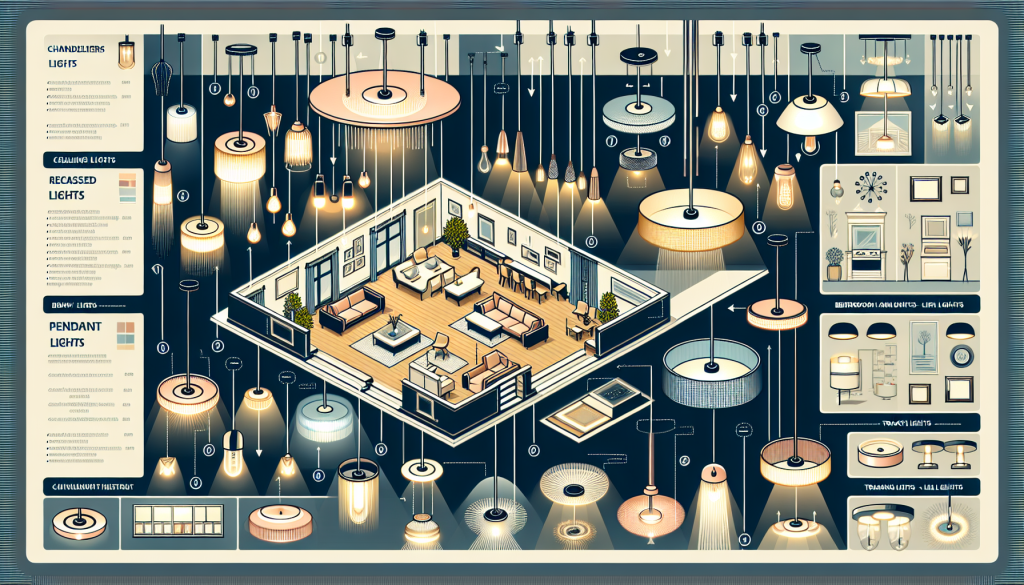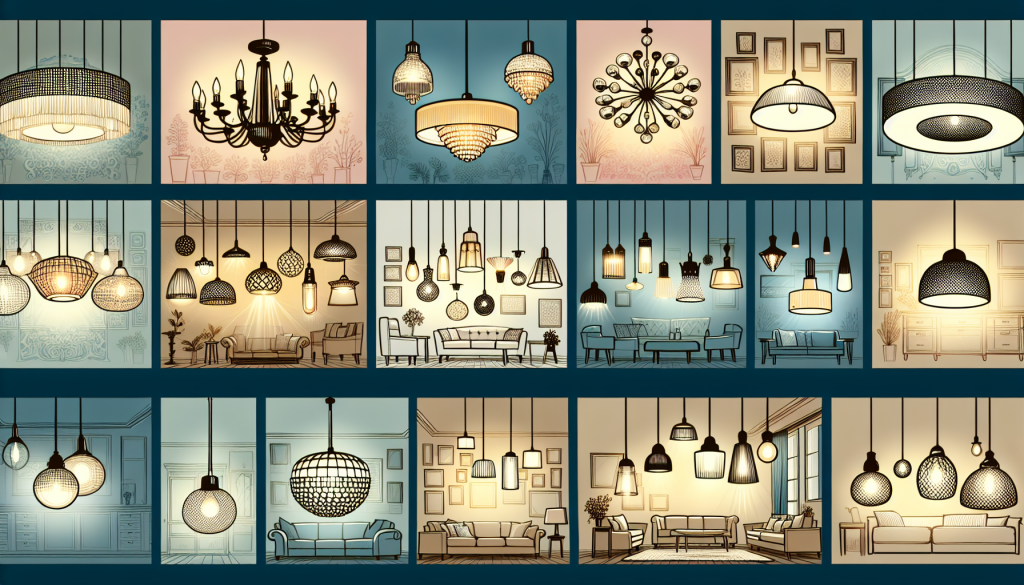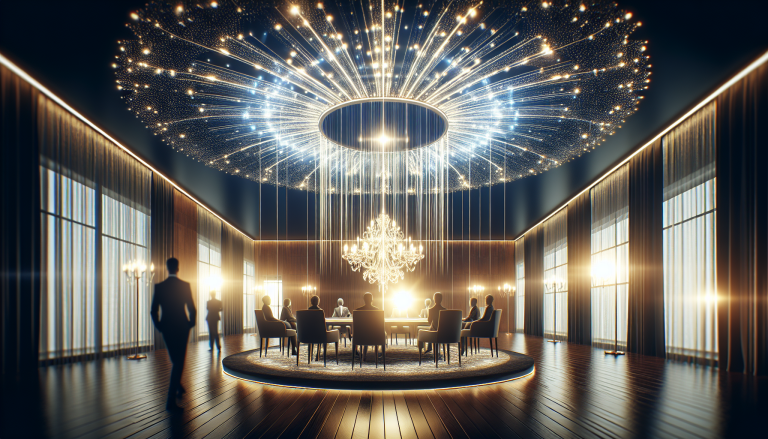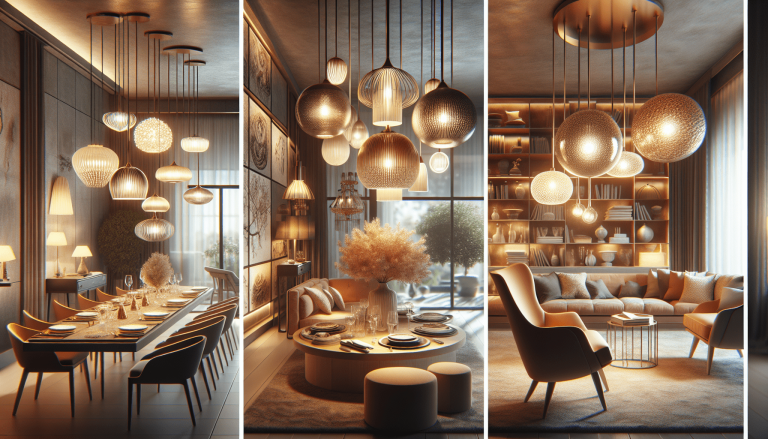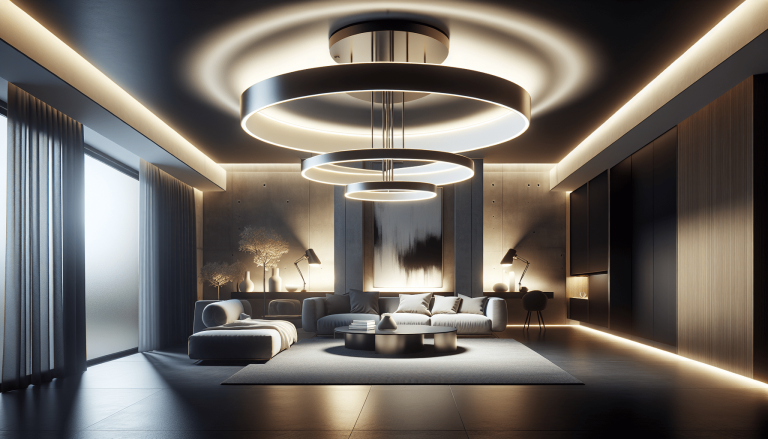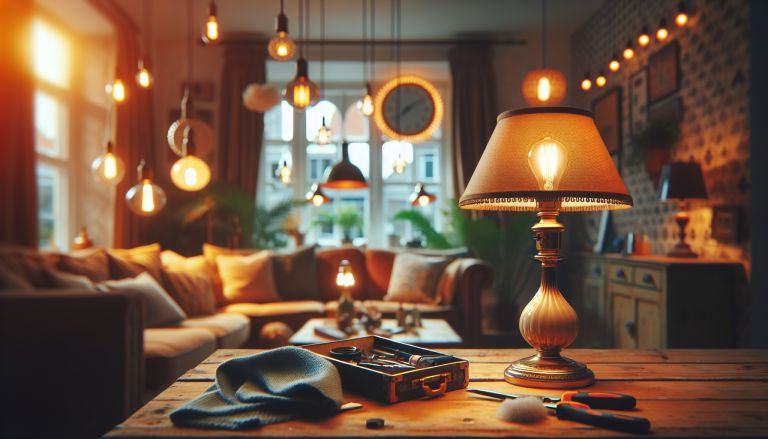Choosing the right ceiling lights for your home can significantly enhance the ambiance and functionality of your space. With an array of options available, it can be overwhelming to narrow down your choices. However, by considering factors such as the size and height of the room, the purpose of the space, and your personal style preferences, you can easily find the perfect ceiling lights that not only illuminate your home but also add an aesthetic appeal to every room. So, whether you’re looking to create a cozy atmosphere in your bedroom or a bright and inviting setting in your kitchen, this article will guide you through the process of choosing the right ceiling lights for your home.
Table of Contents
ToggleTypes of Ceiling Lights
When it comes to ceiling lights, there are various types to choose from, each with its own unique style and functionality. Let’s explore the most common types of ceiling lights available on the market:
Chandeliers
Chandeliers are an elegant and extravagant option for ceiling lighting. They often feature multiple arms with light bulbs and hang down from the ceiling, making a grand statement in a room. Chandeliers are commonly found in dining rooms or entryways, adding a touch of sophistication and glamour to the space.
Pendant Lights
Pendant lights are versatile and popular ceiling fixtures that hang down from a cord, chain, or rod. They come in various sizes, shapes, and styles, making them suitable for a wide range of spaces. Pendant lights are commonly used in kitchens, dining areas, and living rooms, providing focused and direct lighting that enhances both the aesthetics and functionality of the room.
Flush Mounts
Flush mounts, also known as close-to-ceiling lights, are fixtures that are mounted directly against the ceiling. They offer a sleek and streamlined look while providing general illumination to the room. Flush mounts are ideal for low-ceiling spaces or rooms where a minimalist design is desired. They are often used in bedrooms, hallways, or areas with limited ceiling height.
Semi-Flush Mounts
Similar to flush mounts, semi-flush mounts are fixtures that are partially attached to the ceiling, leaving a small gap between the fixture and the ceiling. This design allows for more airflow and creates a unique visual appeal. Semi-flush mounts are suitable for spaces where a slightly more decorative touch is desired, such as living rooms or foyers.
Recessed Lights
Recessed lights, also known as can lights or downlights, are fixtures that are installed into the ceiling, sitting flush with the surface. They offer a clean and streamlined look while providing a focused beam of light. Recessed lights are commonly used for task lighting in kitchens or bathrooms, as well as for creating ambiance in living areas or bedrooms.
Track Lights
Track lights consist of light fixtures mounted on a track system that can be adjusted and repositioned as needed. They offer versatility and flexibility, allowing you to direct the light to specific areas of the room. This makes them ideal for highlighting artwork, architectural features, or creating a spotlight effect. Track lights are commonly used in galleries, retail spaces, or areas where adjustable lighting is desired.
Ceiling Fans with Lights
Ceiling fans with lights combine the functionality of a fan and a light fixture into one. These fixtures provide both cooling and illumination, making them a popular choice for bedrooms, living rooms, or outdoor spaces like patios or porches. Ceiling fans with lights come in various styles and sizes, allowing you to find the perfect fit for your space.
Wall Sconces
While not technically ceiling lights, wall sconces are worth considering when planning your lighting scheme. These fixtures are mounted on walls and provide additional lighting and decorative accents. Wall sconces are often used in hallways, bathrooms, or alongside mirrors to create a warm and inviting atmosphere.
Spotlights
Spotlights are adjustable fixtures that can be installed on the ceiling to provide focused and directional lighting. They are commonly used to highlight artwork, architectural features, or specific areas in a room. Spotlights offer versatility and customization, allowing you to create a dramatic and impactful lighting design.
Track Lighting Kits
Track lighting kits offer an all-in-one solution for your lighting needs. These kits include a track system along with multiple light fixtures, providing you with flexibility and convenience. Track lighting kits are ideal for modern and contemporary spaces, allowing you to create a customized lighting design that suits your style and preferences.
Consider the Room Size and Ceiling Height
When selecting ceiling lights for your home, it’s essential to consider the size of the room and the height of the ceiling. Choosing the right type and size of the light fixture ensures that it not only fits the space visually but also provides adequate lighting for the room.
Large Rooms with High Ceilings
For large rooms with high ceilings, such as grand living rooms or expansive entryways, you have the freedom to choose larger and more substantial light fixtures. Chandeliers or large pendant lights with multiple bulbs can make a bold statement in these rooms. Additionally, track lights or recessed lights can provide a balanced and even distribution of light throughout the space.
Small Rooms with Low Ceilings
In small rooms with low ceilings, it’s crucial to choose ceiling lights that don’t overpower the space or make it feel cramped. Flush mounts or semi-flush mounts are excellent options for these rooms as they provide ample lighting without taking up too much visual space. Pendant lights with a compact design or recessed lights can also be suitable choices, as they offer a sleek and minimalist look.
Rooms with Standard Ceiling Heights
For rooms with standard ceiling heights, you have a wide range of options to choose from. Pendant lights or chandeliers can add a touch of elegance and create a focal point in the room. Flush mounts or semi-flush mounts are versatile choices that provide both style and functionality. Recessed lights or track lights can be used to highlight specific areas or create a layered lighting effect.
Consider the Room’s Purpose
When selecting ceiling lights, it’s crucial to consider the purpose of the room. Different rooms have different lighting needs and requirements. Here are a few examples:
- Kitchen: The kitchen requires bright and focused lighting for tasks such as cooking and food preparation. Pendant lights or recessed lights above the countertop and stove area can provide adequate task lighting, while ambient lighting can be achieved with additional fixtures throughout the room.
- Living Room: The living room is a multifunctional space where ambient lighting, task lighting, and accent lighting are essential. A combination of ceiling lights, such as pendant lights or chandeliers, along with floor lamps or table lamps, can create a layered lighting scheme that suits various activities, from entertaining guests to reading a book.
- Bedroom: The bedroom is a space where soft and warm lighting is desirable, promoting relaxation and restful sleep. Wall sconces or pendant lights with dimmers can create a cozy ambiance, while bedside lamps or reading lights provide specific task lighting when needed.
- Bathroom: In the bathroom, it’s important to have bright and shadow-free lighting for grooming and personal care. Recessed lights or flush mounts placed strategically around the vanity area can provide adequate illumination, while a combination of task lighting and ambient lighting ensures a well-lit and functional space.
Consider the Existing Lighting Fixtures
When choosing ceiling lights for your home, it’s important to consider the existing lighting fixtures in the room. You want to ensure that the new fixtures complement the overall lighting design and style of the space. Take note of the types of bulbs, finishes, and styles of the existing fixtures to ensure a cohesive and harmonious look.
Determine the Lighting Needs
To create a well-balanced and functional lighting design, it’s essential to determine the specific lighting needs of each room. Lighting needs can be categorized into four main types: ambient lighting, task lighting, accent lighting, and layered lighting.
Ambient Lighting
Ambient lighting, also known as general lighting, provides overall illumination to a room. It ensures that the space is evenly lit and sets the mood for the room. Ceiling lights, such as flush mounts or chandeliers, are excellent options for ambient lighting as they provide a wide spread of light. The level of ambient lighting needed will depend on the size and purpose of the room.
Task Lighting
Task lighting is focused and directional lighting that helps illuminate specific areas or tasks. It provides the necessary light for activities like reading, cooking, or applying makeup. Pendant lights, track lights, or recessed lights with adjustable heads are ideal for task lighting as they can be directed to the desired area. Task lighting fixtures should be brighter and concentrated to ensure sufficient illumination for the task at hand.
Accent Lighting
Accent lighting is used to highlight or draw attention to specific architectural features, artwork, or decorative elements in a room. Spotlights or track lights with adjustable heads are commonly used for accent lighting. By creating contrast and emphasizing certain areas or objects, accent lighting adds depth and visual interest to a space.
Layered Lighting
Layered lighting involves combining different types of lighting, such as ambient, task, and accent lighting, to create a well-balanced and visually appealing lighting design. By using a combination of ceiling lights, floor lamps, table lamps, and wall sconces, you can create depth, texture, and the desired ambiance in a room. Layered lighting allows for flexibility and versatility, allowing you to adjust the lighting to suit different activities and moods.
Choose the Style and Design
In addition to considering the functionality of the ceiling lights, it’s important to choose fixtures that match the style and design of your home. The style and design of the fixtures play a significant role in enhancing the overall decor and ambiance of a room. Here are some popular styles and designs to consider:
Traditional
Traditional ceiling lights feature classic designs, ornate details, and intricate craftsmanship. They are often characterized by elegant finishes such as brass, bronze, or crystal. Traditional fixtures are timeless and add a sense of sophistication and elegance to any room. They are commonly found in formal dining rooms, entryways, or traditional-style living rooms.
Modern
Modern ceiling lights feature sleek and minimalist designs, clean lines, and a focus on functionality. They often incorporate materials such as brushed nickel, chrome, or glass. Modern fixtures add a contemporary and streamlined look to a space. They are popular in modern-style homes, lofts, or offices.
Transitional
Transitional ceiling lights combine elements from both traditional and modern styles, creating a versatile and timeless look. They feature classic details with clean lines and neutral finishes. Transitional fixtures can effortlessly blend into various decor styles, making them a popular choice for homeowners who want a balance of classic and contemporary elements.
Rustic
Rustic ceiling lights evoke a cozy and natural ambiance. They often feature organic materials such as wood, wrought iron, or distressed metal. Rustic fixtures are inspired by the outdoors and the charm of a country cottage. They are commonly found in cabins, farmhouse-style kitchens, or rustic-themed living rooms.
Industrial
Industrial ceiling lights are inspired by factories and warehouses, featuring raw and rugged designs. They often incorporate materials such as exposed metal, galvanized steel, or clear glass. Industrial fixtures add a vintage and edgy aesthetic to a room. They are popular in loft apartments, industrial-style kitchens, or converted industrial buildings.
Art Deco
Art Deco ceiling lights are characterized by geometric shapes, bold lines, and luxurious materials. They often feature intricate patterns and decorative details. Art Deco fixtures exude a sense of glamour and opulence. They are commonly found in art deco-style homes, upscale hotels, or theaters.
Contemporary
Contemporary ceiling lights encompass a wide range of styles, reflecting current trends and design influences. They can feature a combination of clean lines, unique shapes, and a mix of materials. Contemporary fixtures are versatile and can complement various modern decor styles, from minimalist to eclectic.
Farmhouse
Farmhouse ceiling lights capture the charm and simplicity of rural living. They often feature distressed finishes, rustic elements, and nostalgic details. Farmhouse fixtures add a vintage and cozy feel to a space. They are popular in farmhouse-style kitchens, country-style living rooms, or cottage-inspired bedrooms.
Minimalist
Minimalist ceiling lights embrace simplicity, featuring clean lines, neutral colors, and understated designs. They often have a minimalist silhouette with minimal decorative elements. Minimalist fixtures create a sense of calm and tranquility in a room. They are commonly used in contemporary or Scandinavian-style homes.
Eclectic
Eclectic ceiling lights allow for creativity and personal expression, showcasing a mix of styles, colors, and materials. They can be a combination of different design influences, from vintage to modern, creating a unique and eclectic look. Eclectic fixtures add personality and character to a room. They are popular in bohemian-style homes, artist studios, or eclectic-themed spaces.
When choosing the style and design of your ceiling lights, consider the overall decor and mood you want to create in a room. Select fixtures that harmonize with the existing aesthetics, enhancing the visual appeal and cohesiveness of the space.
Consider the Bulb Type
The type of bulb used in your ceiling lights can significantly impact the quality of light, energy efficiency, and lifespan of the fixture. Here are the most common types of bulbs to consider:
Incandescent Bulbs
Incandescent bulbs are the traditional and most recognizable type of bulb. They produce warm and soft light, creating a cozy ambiance. However, incandescent bulbs are not very energy-efficient and have a limited lifespan compared to newer technologies. They are gradually being phased out in favor of more efficient options.
Halogen Bulbs
Halogen bulbs are an improved version of incandescent bulbs, providing brighter and whiter light. They are more energy-efficient than incandescent bulbs but still consume more energy compared to newer alternatives. Halogen bulbs emit a lot of heat, making them less suitable for enclosed fixtures or rooms where temperature control is important.
LED Bulbs
LED bulbs, or light-emitting diode bulbs, are highly energy-efficient and long-lasting. They use significantly less energy than incandescent or halogen bulbs, resulting in lower electricity bills. LED bulbs are available in a wide range of color temperatures, from warm white to cool white, allowing you to select the desired ambiance for your space. Additionally, LED technology has advanced to provide excellent color rendering, making them suitable for both residential and commercial applications.
CFL Bulbs
Compact fluorescent lamps (CFL) bulbs are another energy-efficient option. They are typically spiral-shaped and provide bright white light. CFL bulbs use less energy and last longer than incandescent bulbs, making them a cost-effective choice in the long run. However, CFL bulbs take some time to reach full brightness and contain a small amount of mercury, requiring special disposal procedures.
When selecting the bulb type for your ceiling lights, consider the desired brightness, color temperature, energy efficiency, and lifespan. LED bulbs are generally the recommended choice for most applications due to their energy efficiency, long lifespan, and versatility.
Select the Right Color Temperature
Color temperature refers to the warmth or coolness of light emitted by a bulb, measured in kelvin (K). Choosing the right color temperature is essential as it can greatly affect the mood and atmosphere of a room. Here are the most common color temperature options to consider:
Warm White (2700K-3000K)
Warm white light creates a cozy and inviting ambiance, similar to the glow of an incandescent bulb. It is ideal for spaces where a relaxed and comfortable atmosphere is desired, such as bedrooms, living rooms, or dining rooms. Warm white light enhances warm-colored decor and creates a sense of intimacy.
Cool White (3500K-4100K)
Cool white light has a brighter and more neutral appearance, resembling natural daylight. It is commonly used in task-oriented spaces such as kitchens, bathrooms, or work areas. Cool white light provides excellent color accuracy, making it suitable for activities that require clear visibility and focus.
Daylight (5000K-6500K)
Daylight or daylight white light is the brightest and coolest option, simulating the brightness of natural daylight. It is commonly used in commercial spaces, garages, or areas where maximum brightness and visibility are required. Daylight white light can create a crisp and energizing atmosphere.
When determining the color temperature for your ceiling lights, consider the purpose and function of the room, as well as the mood and ambiance you want to create. A combination of different color temperatures in different areas of your home can add depth and variety to your lighting design.
Pay Attention to the Lumen Output
Lumen output refers to the brightness or intensity of light produced by a bulb or fixture. It is an important factor to consider when selecting ceiling lights, as it determines how much light is emitted and how well the space is illuminated. Here are some things to consider:
Bright Light for Task Areas
For areas where specific tasks are performed, such as kitchens or workspaces, it’s important to choose ceiling lights with a higher lumen output. Bright and focused light ensures that the activities are well-illuminated and visually comfortable. Recessed lights or pendant lights with high lumen output are suitable choices for task areas.
Soft, Ambient Light for Living Spaces
In living spaces like bedrooms, living rooms, or dining rooms, a softer and more diffused light is often desired. This creates a cozy and comfortable ambiance for relaxation and socializing. Ceiling lights with a moderate lumen output, such as chandeliers or flush mounts, can provide a warm and inviting glow that fills the space without being too bright or harsh.
Matching Lumens to Existing Lighting
When adding new ceiling lights to a room, it’s important to consider the lumen output of the existing lighting fixtures. Different lighting fixtures may have different lumen outputs, and it’s important to maintain a consistent level of light throughout the space. Take note of the existing bulbs or fixtures and choose new ceiling lights that provide a similar lumen output to ensure a seamless and uniform lighting design.
Consider Energy Efficiency
Besides providing adequate lighting, energy efficiency is an important consideration when choosing ceiling lights. Energy-efficient fixtures and bulbs not only help reduce electricity bills but also contribute to a sustainable and environmentally-friendly home. Here are some factors to consider for energy-efficient lighting:
Energy Star Certified Fixtures
Look for ceiling lights that are Energy Star certified. Energy Star is a program that identifies and promotes energy-efficient products. Fixtures with the Energy Star label meet strict energy efficiency guidelines and are proven to consume less energy without sacrificing performance or quality.
Lighting Controls and Dimmers
Installing lighting controls and dimmers can significantly enhance energy efficiency. These devices allow you to adjust the brightness of your ceiling lights according to your needs, saving energy and providing flexibility in lighting levels. Dimmers are particularly useful in spaces where a range of light intensities is desired, such as dining rooms or bedrooms.
Energy-efficient Bulbs
Opt for energy-efficient bulbs, such as LED or CFL bulbs, as mentioned earlier. These bulbs use significantly less energy than traditional incandescent or halogen bulbs, resulting in reduced energy consumption and cost savings. LED bulbs, in particular, have a long lifespan and low energy requirements, making them a highly energy-efficient option.
Consider Natural Lighting
Take advantage of natural lighting in your home by maximizing natural light sources, such as windows or skylights. This reduces the need for artificial lighting during the day, saving energy and creating a brighter and more uplifting atmosphere. Utilize curtains, blinds, or shades to control the amount of natural light entering the room and minimize glare or heat gain as needed.
By incorporating energy-efficient practices into your lighting design, you can create a more sustainable and cost-effective home environment.
Evaluate Installation and Maintenance
When selecting ceiling lights, it’s important to consider the practical aspects of installation and maintenance. Here are some factors to evaluate:
Ceiling Type and Structure
Consider the type and structure of your ceiling when choosing ceiling lights. Some fixtures may require specific mounting methods or additional support. For example, if you have a plaster ceiling, you may need to consult a professional to ensure proper installation. Suspended or drop ceilings may require additional considerations when selecting fixtures. Evaluate the ceiling type and structure to determine the suitability and ease of installation.
Ease of Installation
Choose ceiling lights that are easy to install, especially if you plan on doing the installation yourself. Some fixtures may require professional installation, while others come with simple installation instructions. Consider your level of expertise and the complexity of the fixture to ensure a smooth and hassle-free installation process.
Cleaning and Maintenance
Consider the cleaning and maintenance requirements of the ceiling lights. Some fixtures may have intricate designs or require special cleaning methods. Others may have removable parts that make cleaning easier. Take into account the effort and time required for cleaning and maintenance when selecting fixtures, ensuring they fit into your lifestyle and maintenance routine.
Warranty and Support
Check the warranty and support provided by the manufacturer or retailer. A reliable warranty ensures that you can address any issues or defects that may occur with the fixture. Research customer reviews or ratings to gauge the overall customer satisfaction and support provided by the manufacturer or retailer. A reputable and supportive warranty gives you peace of mind and confidence in your purchase.
Set a Budget
Setting a budget is an important step when choosing ceiling lights for your home. By determining a reasonable budget, you can narrow down your options and make informed decisions. Here are some considerations when setting a budget:
Determining a Reasonable Budget
Consider your overall home improvement budget and allocate a portion to ceiling lights. Determine the importance of lighting in your home and the desired level of investment. Setting a budget helps you prioritize and prevents overspending on lighting fixtures.
Comparing Prices and Features
Research and compare prices and features of different ceiling lights to find the best value for your budget. Consider factors such as quality, energy efficiency, design, and functionality when evaluating the price. Look for sales, promotions, or discounts to maximize your budget.
Considering Long-term Costs
While it may be tempting to choose the most affordable option, consider the long-term costs associated with the ceiling lights. Energy-efficient lighting fixtures and bulbs may have a higher upfront cost but can result in significant energy savings over time. Take into account the lifespan and maintenance requirements of the fixtures to determine their true cost-effectiveness.
By setting a budget and considering factors such as price, quality, and long-term costs, you can make informed decisions and find the perfect ceiling lights that meet your needs and financial considerations.
In conclusion, choosing the right ceiling lights for your home is a crucial step in creating a well-lit, functional, and aesthetically pleasing space. Consider the different types of ceiling lights available, evaluate the size and height of the room, determine the lighting needs, select a style and design that suits your preferences, choose the appropriate bulb type, and pay attention to energy efficiency and maintenance requirements. Set a budget that aligns with your overall home improvement plans, and take the time to compare prices and features to find the best fit for your space. By following these guidelines, you can illuminate your home with the perfect ceiling lights that enhance the ambiance, functionality, and style of each room. Happy lighting!

